Vila Nova de Gaia
Vila Nova de Gaia (Portuguese pronunciation: [ˈvilɐ ˈnɔvɐ ðɨ ˈɣajɐ] (![]()
Vila Nova de Gaia | |
|---|---|
_(cropped).jpg) _(cropped).jpg) .jpg) _(cropped).jpg) _(2).jpg) .jpg) | |
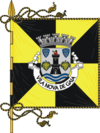 Flag 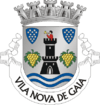 Coat of arms | |
 | |
| Coordinates: 41°08′N 8°37′W | |
| Country | |
| Region | Norte |
| Metropolitan area | Porto |
| District | Porto |
| Parishes | 15 |
| Government | |
| • President | Eduardo Vitor Rodrigues (PS) |
| Area | |
| • Total | 168.46 km2 (65.04 sq mi) |
| Population (2011) | |
| • Total | 302,295 |
| • Density | 1,800/km2 (4,600/sq mi) |
| Time zone | UTC±00:00 (WET) |
| • Summer (DST) | UTC+01:00 (WEST) |
| Website | www |
The city contains many cellars (locally known as "caves") where port wine is stored and aged. These cellars have become a major tourist attraction.
History
Vila Nova de Gaia already existed under the Roman Empire as the city of Cale. It developed most likely from a preexistent Celtic Castro, or Neolithic settlement. The origin of the name Cale[4] (or Gale, since in Classical Latin there was not always a clear distinction between the letters "g" and "c") is likely Celtic, from the root "Gall-" with which Celts referred to themselves, similarly to Galicia, Gaul or Galway. The river itself has a Celtic name, Douro (Latinised Durus) after Celtic "dwr", deep water, water or river.[5][6] In Roman times the bulk of the population probably lived south of the river Douro, and on the north side, there was a smaller settlement around the deep water port which now is the Ribeira neighbourhood of Porto. The name of Porto, in high medieval times Portus Cale, thus stood for the harbour ("portus" in Latin) of the city of Cale. With the important trade of the river Douro, which is easily navigable up to the Régua deep inland, the Porto part of the city came to overgrow Cale, and became the most important part of town, where the Bishopric and the merchants were established.

With the Moorish invasions in the eighth century, the de facto frontier between the Islamic state and the Christian one came to rest for a considerable period of time on the river Douro. With the constant raids and counter-raids, the town of Cale, or Gaia, was deserted and most of its inhabitants took refuge in Porto in the North side of the river. It is in this period, the tenth century, that the late medieval Lenda de Gaia (Legend of Gaia) is set. After the conquest and pacification of the southern side of the Douro river after 1035, with the exodus or expulsion of the Muslim populations, leaving behind semi-abandoned fertile lands, colonists from the north settled in exchange for better feudal contracts with the newly appointed lords. These migrants refounded the old city of Cale or Gaia under the name of Vila Nova de Gaia (new town of Gaia) around the old castle and ruins of "old Gaia".
The name of the double city of Porto and Gaia was frequently referred to in contemporary documents as "villa de Portucale", and the county of the Kingdom of León which was centered on it was named Condado Portucalense. This county was eventually expanded and after gaining its independence, became the Kingdom of Portugal.
Parishes
Administratively, the municipality is divided into 15 civil parishes (freguesias):[7]
| Parish | Population[8] | Area (km²)[2] |
|---|---|---|
| Arcozelo | 14,352 | 8.50 |
| Avintes | 11,497 | 8.82 |
| Canelas | 13,459 | 6.90 |
| Canidelo | 27,769 | 8.93 |
| Grijó e Sermonde | 11,938 | 12.99 |
| Gulpilhares e Valadares | 22,019 | 10.61 |
| Madalena | 10,040 | 4.69 |
| Mafamude e Vilar do Paraíso | 52,422 | 10.58 |
| Oliveira do Douro | 22,383 | 7.54 |
| Pedroso e Seixezelo | 20,426 | 20.88 |
| Sandim, Olival, Lever e Crestuma | 17,168 | 34.16 |
| Santa Marinha e São Pedro da Afurada | 33,714 | 6.91 |
| São Félix da Marinha | 12,706 | 7.93 |
| Serzedo e Perosinho | 14,250 | 11.97 |
| Vilar de Andorinho | 18,155 | 7.07 |
The parish Santa Marinha e São Pedro da Afurada contains the city centre of Vila Nova de Gaia.
Coat of arms and flag
The coat of arms consists of a grey crest with two golden-yellow bunches of grapes on the bottom with a black castle over the water, and with a person blowing the horn. The grapes intend to represent the city's connection with the wine industry, mainly Port wine, whose cellars are in the lower part of the city.
The flag is colored dark yellow to black in four each.
Leisure
Beaches
Vila Nova de Gaia is the Portuguese municipality with the biggest number of Blue Flag beaches in 2009 and in 2010: 17 beaches along 17 km of seaside. Some popular beaches are: Miramar, Granja, Aguda, Valadares, Francelos, Madalena and Canidelo.[9]Praia da Granja is a FEE Blue Flag beach in the parish of São Félix da Marinha. This area was a farm in the 18th century belong to the Grijó Monastery and used as a rest place of monks and priests.[10]
Parks and gardens
- Gaia Biological Park (Portuguese: Parque Biológico de Gaia) is the largest park in the city, with an area of 35 hectares. The Park established in 1983 as an environmental education center, features a 3 km walkway along with hundreds of species of animals and plants.[11][12][13]
- Opened in August 2005, the Lavandeira Park (Portuguese: Parque da Lavandeira) is a place for leisure activities with a lake, pedestrian walks, picnic areas and theme gardens. It has an area of 11 hectares located in Oliveira do Douro.[14][15][16][17][18]
- Jardim do Morro ("Garden of the Hill") is a garden located in the parish of Santa Marinha, near the Sera do Pilar Monastery. It was established in 1927. There is a lake, a number of plant species including Tilias.[19]
- The Littoral Station of Aguda (Portuguese: Estação Litoral da Aguda) is a show aquarium opened in 1999 on the beach of Aguda (Portuguese: Praia da Aguda) in Arcozelo. The building designed by the architect João Paulo Peixoto includes 3 main sections: Fisheries Museum displaying fishery equipment; Aquarius demonstrating local aquatic fauna and flora, and the Department of Environmental Education and Scientific Research on marine ecology, fishery and aquaculture.[20][21][22]
- Local Nature Reserve of the Douro Estuary (Portuguese: Reserva Natural Local do Estuário do Douro) is a small nature reserve established in 2007 with the aim of the protection of birds and landscape. There can be seen cormorants, herons, white egrets, tortoises, sea turtles, plovers, red knots, various species of seagulls, kingfishers among many other birds throughout a year. São Paio Bay is a popular spot for bird watchers.[18][23]
There are also Dunes Park (Portuguese: Parque de Dunas), Botanical Park of Castelo (Portuguese: Parque Botanico do Castelo), Camelias Garden (Portuguese: Jardim das Camélias), Streams of Gaia (Portuguese: Ribeiras de Gaia), Maria Pia Bridge Park (Portuguese: Parque Ponte Maria Pia) in Vila Nova de Gaia.[18]
- Gaia Biological Park
- Jardim do Morro
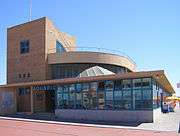 Littoral Station of Aguda
Littoral Station of Aguda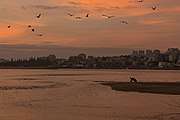 Nature Reserve of the Douro Estuary
Nature Reserve of the Douro Estuary.jpg)
Tourism
The city attracts a great number of tourists for its different points of interest and the wine cellars are considered to be a must-see in any trip to area of Porto.
Museums
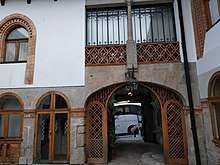
House-Museum Teixeira Lopes| Diogo de Macedo Gallery (Portuguese: Casa-Museu Teixeira Lopes| Galerias Diogo de Macedo) is a cultural center consisting of the house of the sculptor António Teixeira Lopes and recently built Diogo de Macedo Galleries located in Vila Nova de Gaia. The building of the museum was constructed in 1895 by António Teixeira Lopes and his brother José Teixeira Lopes as a residence and an atelier. The Master donated this property to the municipality of Vila Nova de Gaia, and it was opened to the public as a house-museum in 1933. Diogo de Macedo Gallery was established in 1975 in a building annexed to Teixeira Lopes' atelier. The Art Galleries in the House-museum demonstrates works of Portuguese painters and sculptors, as well as pieces of pottery factories of Gaia, while Diogo de Macedo Galleries display the sculptural works of Diogo de Macedo and his art collection consisting of decorative art examples from 16th-20th centuries.[24][25]
Solar dos Condes de Resende is a former manorial property which is now the headquarter of the Municipal House of Culture located in the village of Negrelos. Its construction dates back to the Medieval Ages. In the 16th century, the property belonged to Tomé da Costa, a nobleman from Vila Nova de Gaia who served for the Kingdom during the period of the Philippine dynasty. The building was also known as Quinta da Costa. The building has a semi-public chapel dedicated to São Tomé, a baroque garden with camellias and a large tank of stonework that receives water from the source of São Mamede in Serra de Canelas. There is also a statue dedicated to the writer Eça de Queiroz who fell in love with the daughter of the owner (4th Count of Resende) and married her (Emília de Castro Pamplona). After the City Council of Gaia purchased the property in 1984, it has been operating as Municipal House of Culture. There is a Documentation Center for History, Archaeology, Art and Anthropology, as well as a museum site with Azuaga Marciano Collection.[26][27]
Gallery
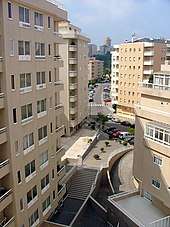 Apartment buildings in the parish of Mafamude
Apartment buildings in the parish of Mafamude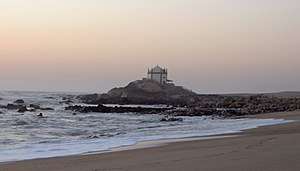 Beach in Miramar
Beach in Miramar- Metro next to El Corte Inglés
- Soares dos Reis Square
 Gaia at night
Gaia at night.jpg) Gaia
Gaia- Vila Nova de Gaia
 Tower Plaza Regino, Gaia
Tower Plaza Regino, Gaia Vila Nova de Gaia
Vila Nova de Gaia Downtown Gaia
Downtown Gaia- Vila Nova de Gaia
 Vila Nova de Gaia TV Tower
Vila Nova de Gaia TV Tower Vila Nova de Gaia
Vila Nova de Gaia Porto Urban Area
Porto Urban Area.jpg) Vila Nova de Gaia
Vila Nova de Gaia- Gaia
Sister City
Vila Nova de Gaia is twinned with:
![]()
References
- Uma População que se urbaniza, Uma avaliação recente - Cidades, 2004 Archived October 6, 2014, at the Wayback Machine Nuno Pires Soares, Instituto Geográfico Português (Geographic Institute of Portugal)
- "Áreas das freguesias, concelhos, distritos e país". Archived from the original on 2018-11-05. Retrieved 2018-11-05.
- Instituto Nacional de Estatística
- http://www.faclair.com/?txtSearch=Cala
- ^ Matasović, Ranko (2009), “*dubro-”, in Etymological Dictionary of Proto-Celtic (Leiden Indo-European Etymological Dictionary Series; 9), Leiden: Brill, ISBN 978-90-04-17336-1, pages 107-108
- ^ Wodtko, Dagmar S.; Irslinger, Britta; Schneider, Carolin (2008), “*dʰeu̯b-”, in Nomina im indogermanischen Lexikon [Nouns in the Indo-European Lexicon] (in German), Heidelberg: Universitätsverlag Winter, pages 122-124
- Diário da República. "Law nr. 11-A/2013, pages 552 134-135" (PDF) (in Portuguese). Retrieved 4 August 2014.
- Instituto Nacional de Estatística (INE), Census 2011 results according to the 2013 administrative division of Portugal
- "Praias". www.cm-gaia.pt (in Portuguese). Retrieved 2019-01-25.
- "Próxima paragem? Praia da Granja". PÚBLICO (in Portuguese). Retrieved 2019-01-25.
- "Parque Biologico de Gaia". www.parquebiologico.pt. Retrieved 2019-01-25.
- "Parque Biologico de Gaia - Evolution". www.parquebiologico.pt. Retrieved 2019-01-25.
- "Parque Biológico de Gaia: 30 anos de proteção ambiental - JPN". JPN - JornalismoPortoNet (in Portuguese). Retrieved 2019-01-25.
- "Parque da Lavandeira". www.parquebiologico.pt. Retrieved 2019-01-25.
- Manha, Correio da. "Gaia vai ampliar parque da Lavandeira e reabilitar estufa do século XIX". www.cmjornal.pt (in Portuguese). Retrieved 2019-01-25.
- Gaia, Câmara Municipal de. "Parque da Cidade - Espaços ao ar livre - Desporto - Cidade - Câmara Municipal de Gaia". www.cm-gaia.pt (in Portuguese). Retrieved 2019-01-25.
- "Parque da Lavandeira - O que fazer". www.portoenorte.pt. Retrieved 2019-01-25.
- "Parques". www.cm-gaia.pt (in Portuguese). Retrieved 2019-01-25.
- Carla Sofia Luz. "Jardim do Morro será recuperado no verão". Jornal de Notícias. Retrieved 2019-01-25.
- "ELA - Littoral Station of Aguda". www.fundacao-ela.pt. Retrieved 2019-01-25.
- "ELA - History". www.fundacao-ela.pt. Retrieved 2019-01-25.
- "Estação Litoral da Aguda". www.cm-gaia.pt (in Portuguese). Retrieved 2019-01-25.
- "Reserva Natural Local do Estuário do Douro - Qué hacer". www.portoenorte.pt. Retrieved 2019-01-25.
- "House-Museum of Teixeira Lopes". www.cm-gaia.pt (in Portuguese). Retrieved 2019-01-31.
- "Casa-Museu Teixeira Lopes". www.patrimoniocultural.gov.pt. Retrieved 2019-01-31.
- "Solar Condes de Resende". www.monumentos.gov.pt. Retrieved 2019-01-31.
- "Solar Condes de Resende". www.cm-gaia.pt (in Portuguese). Retrieved 2019-01-31.
External links
| Wikimedia Commons has media related to Vila Nova de Gaia. |

